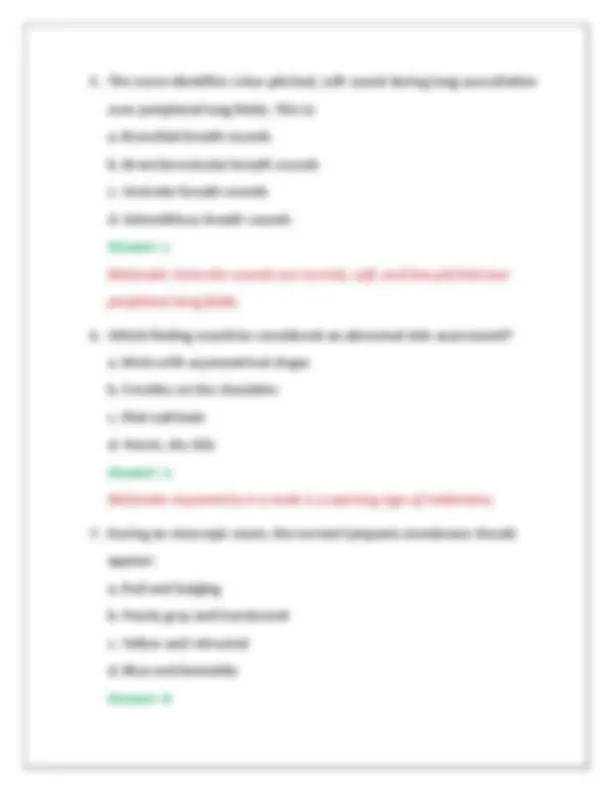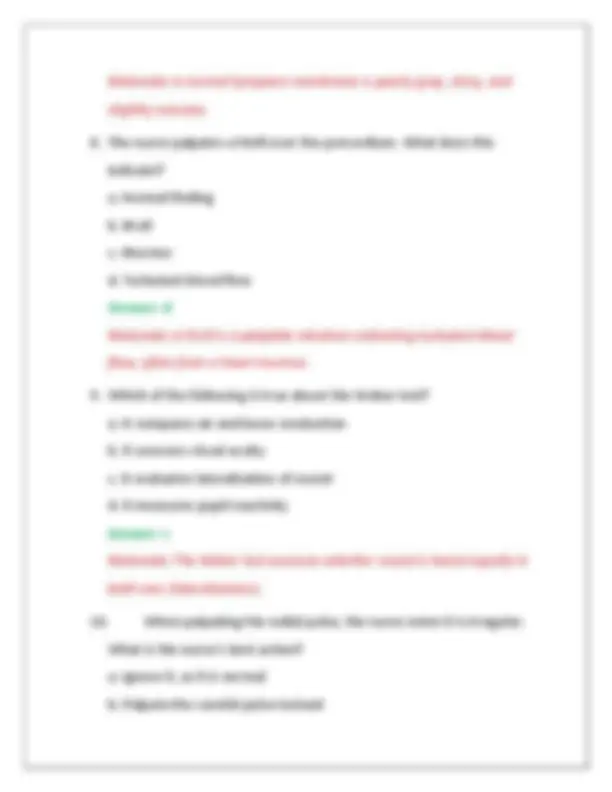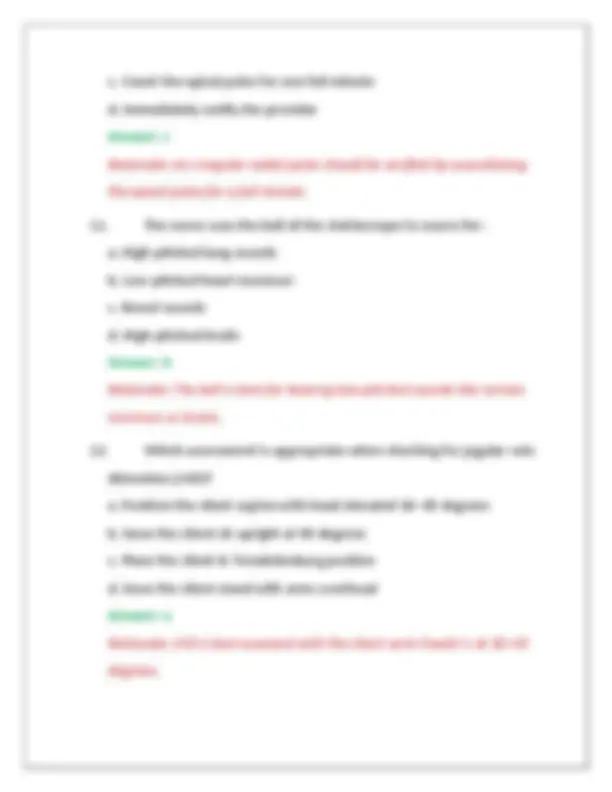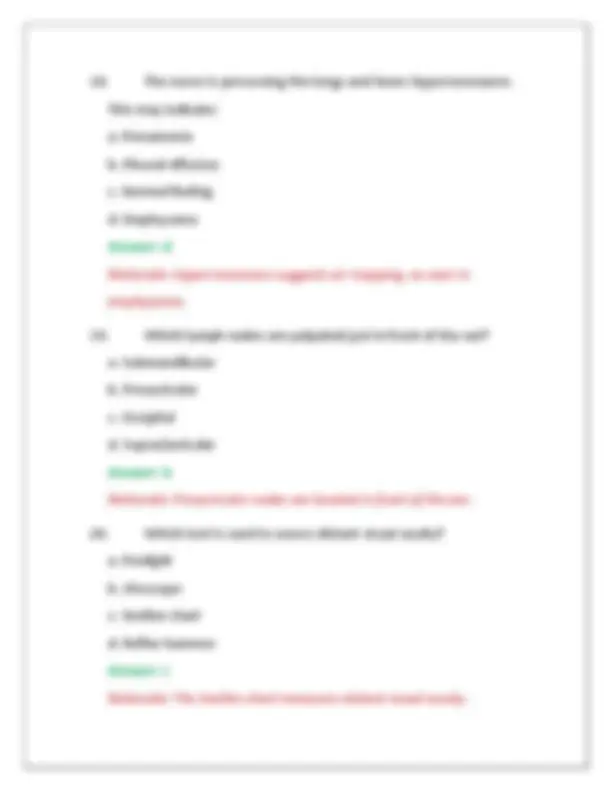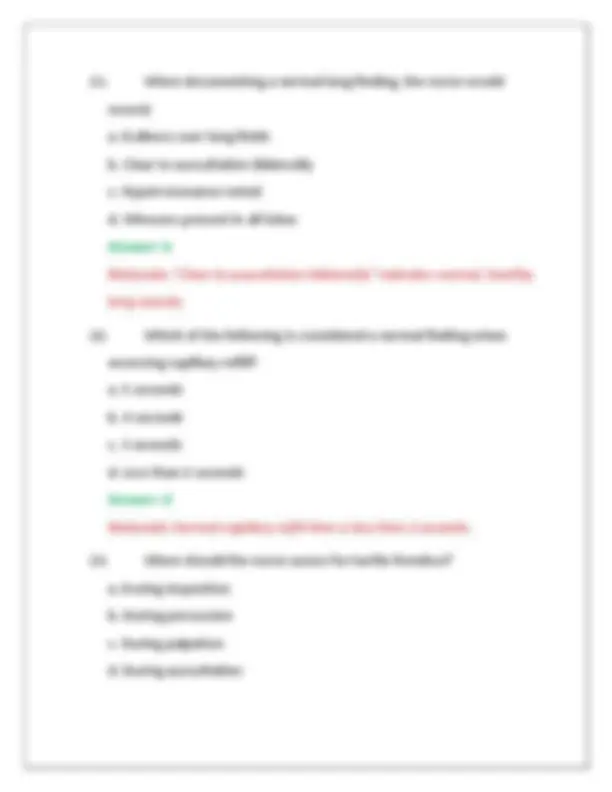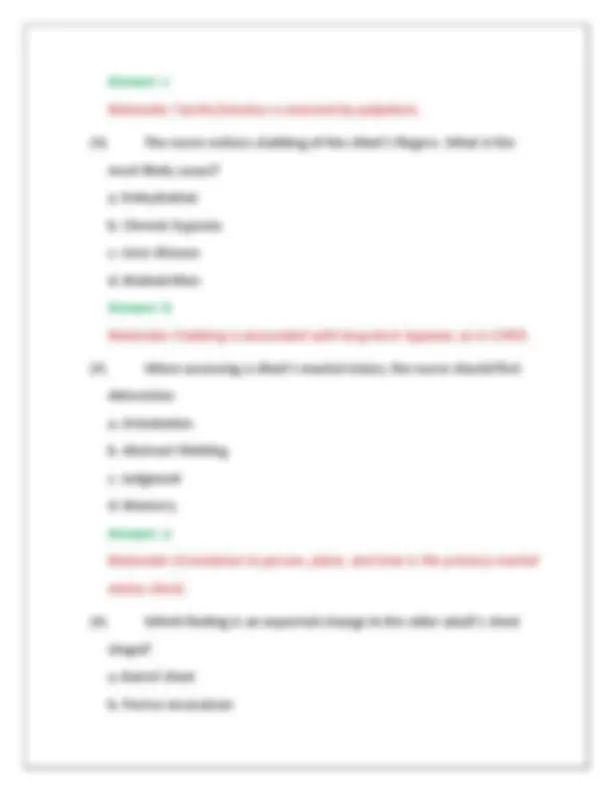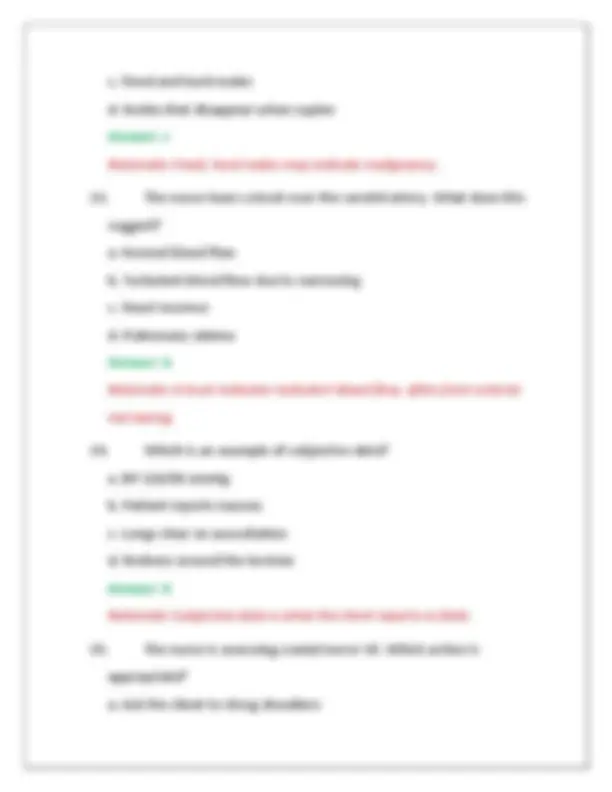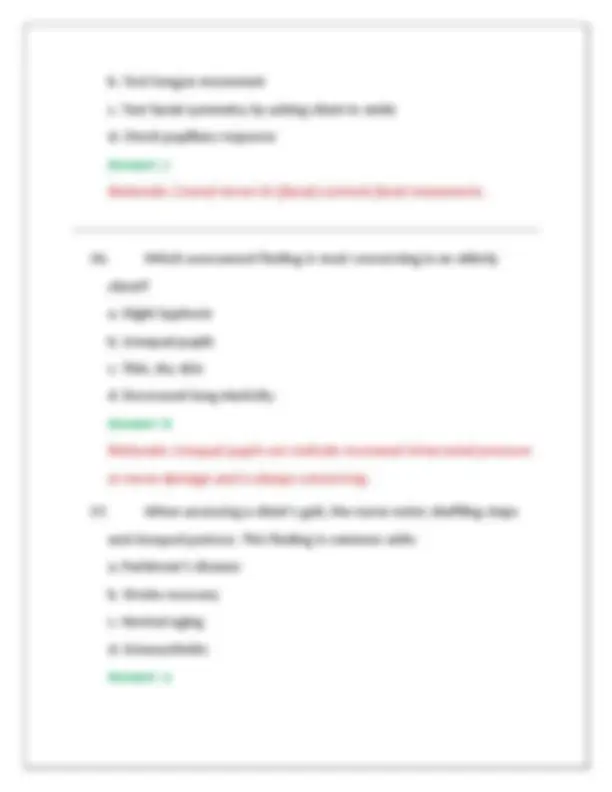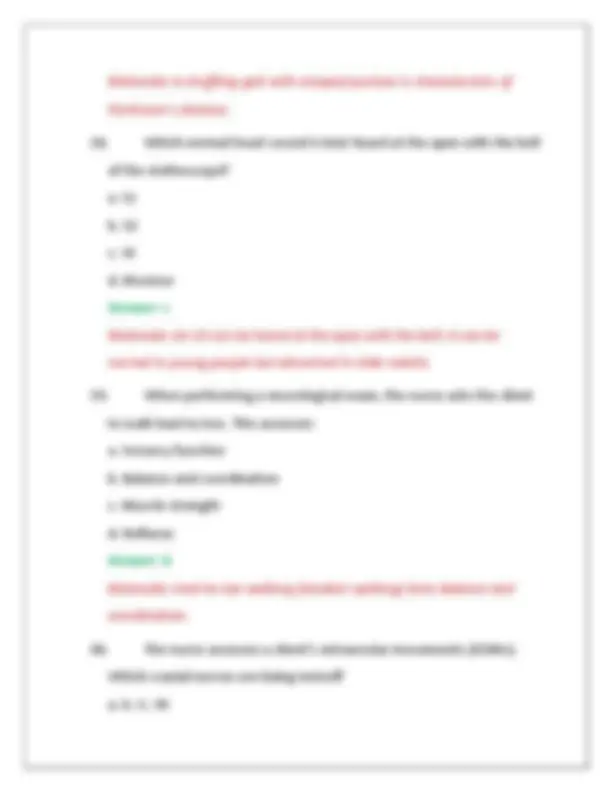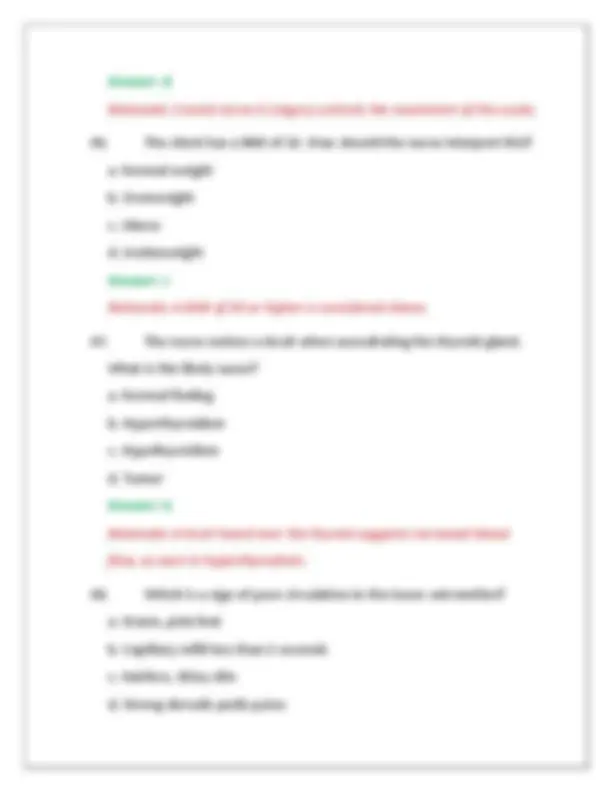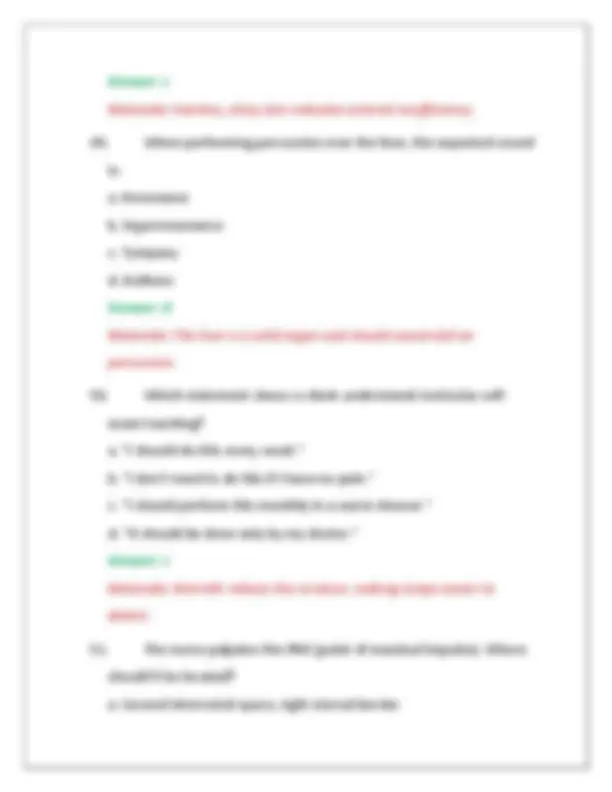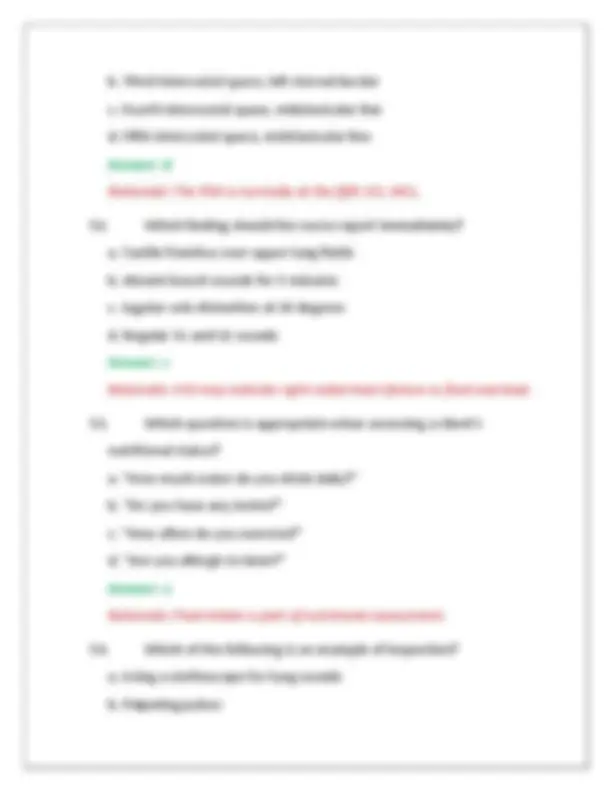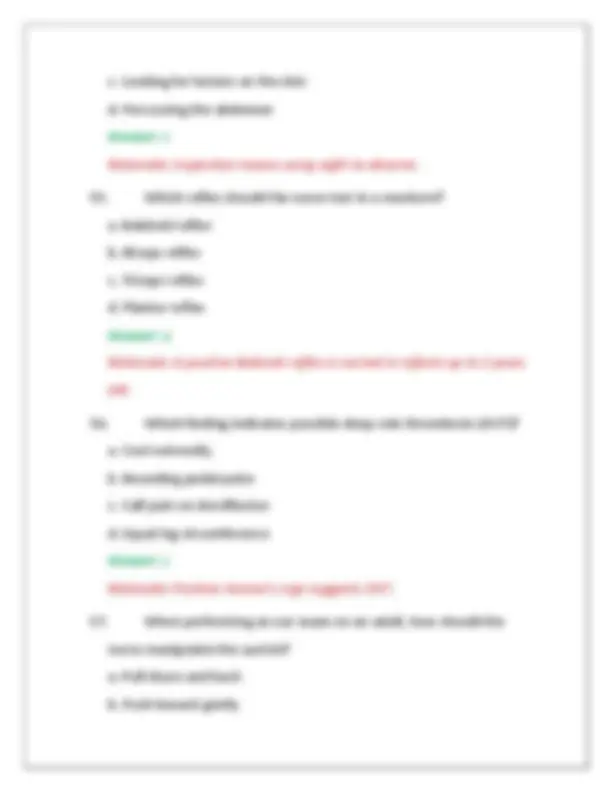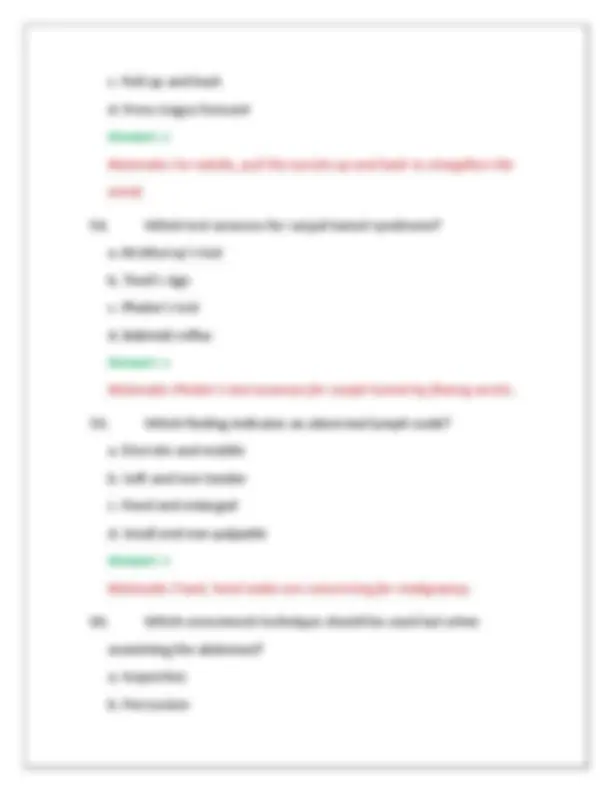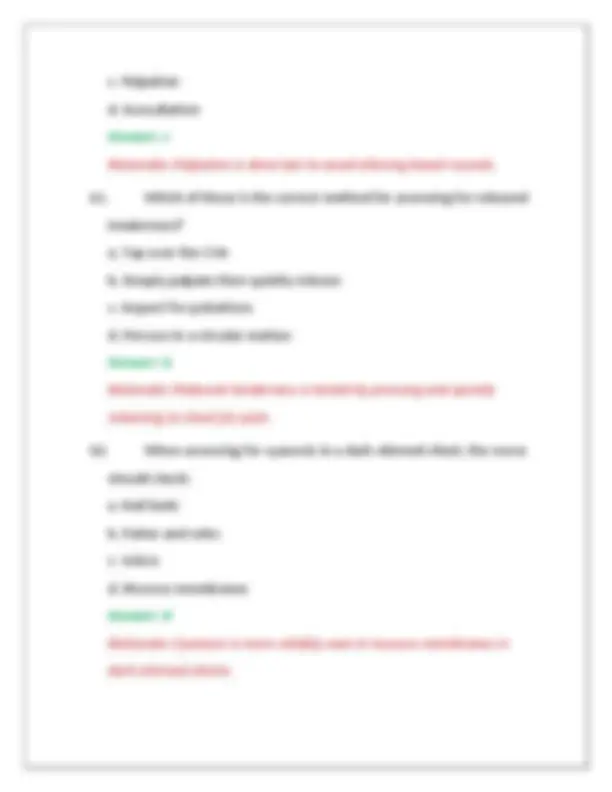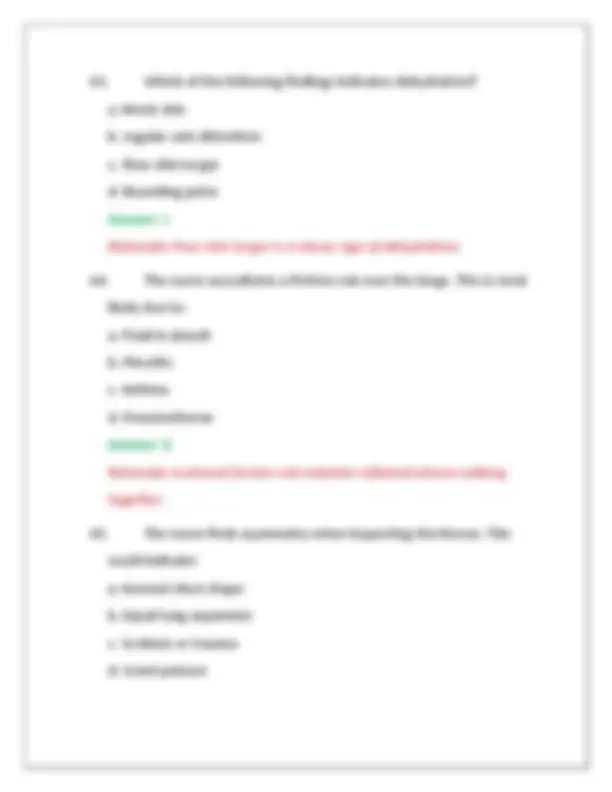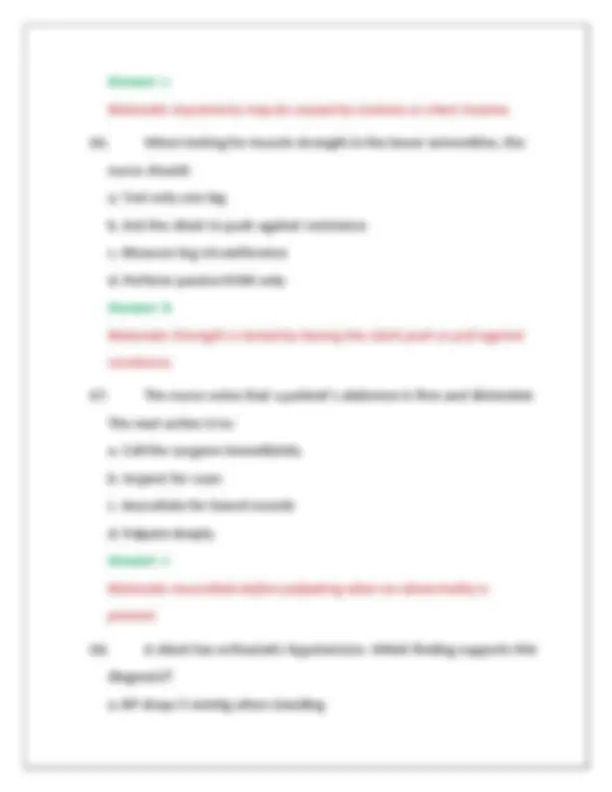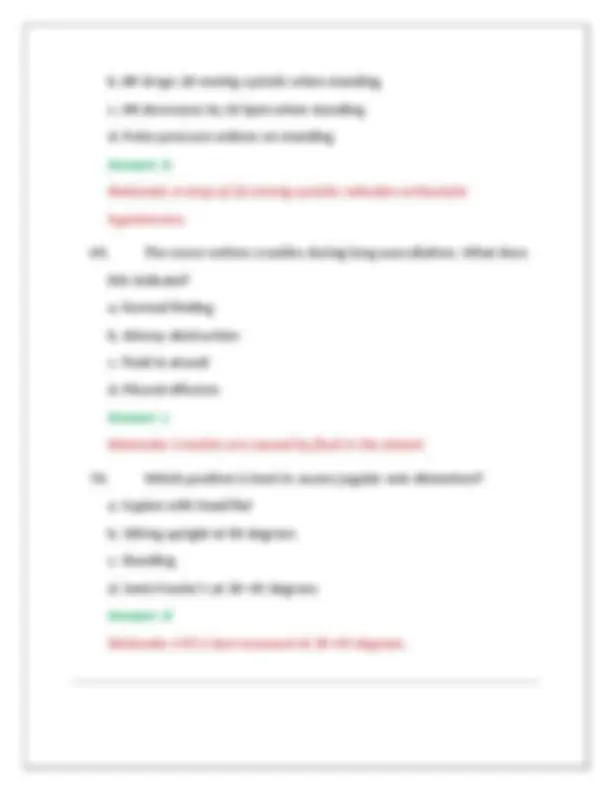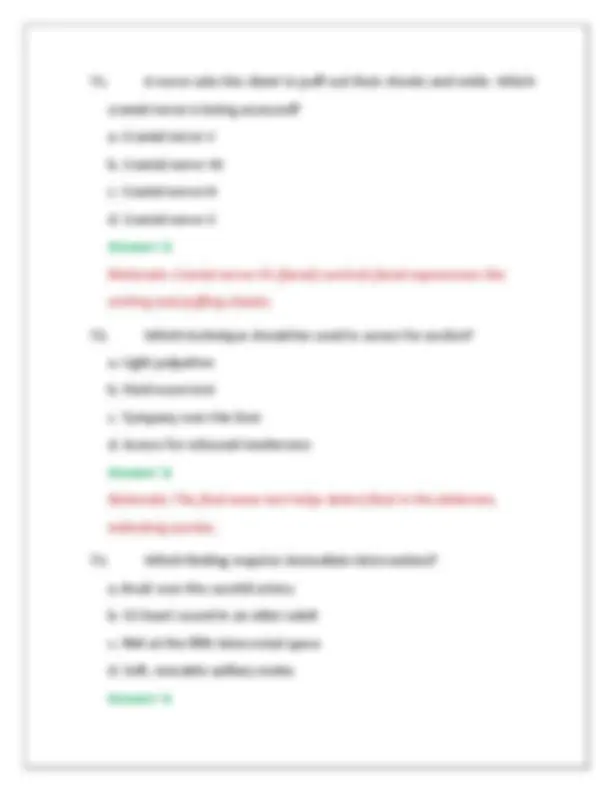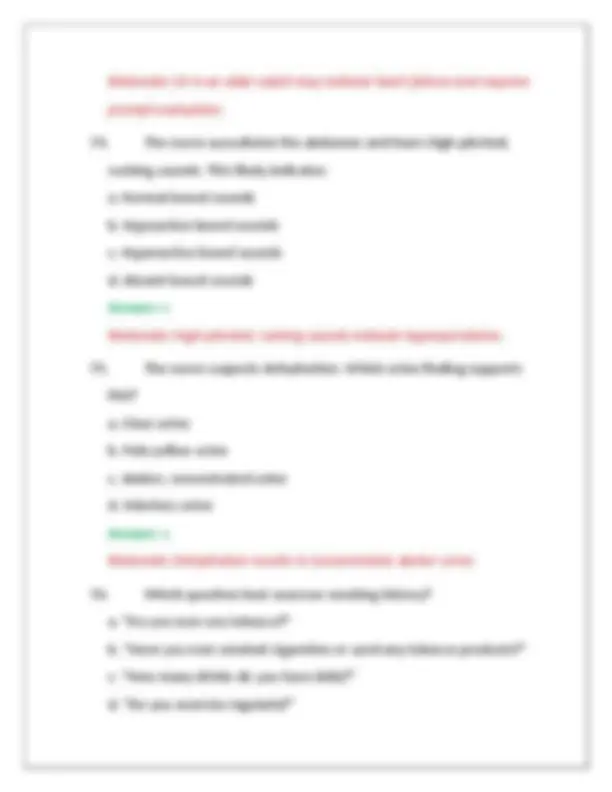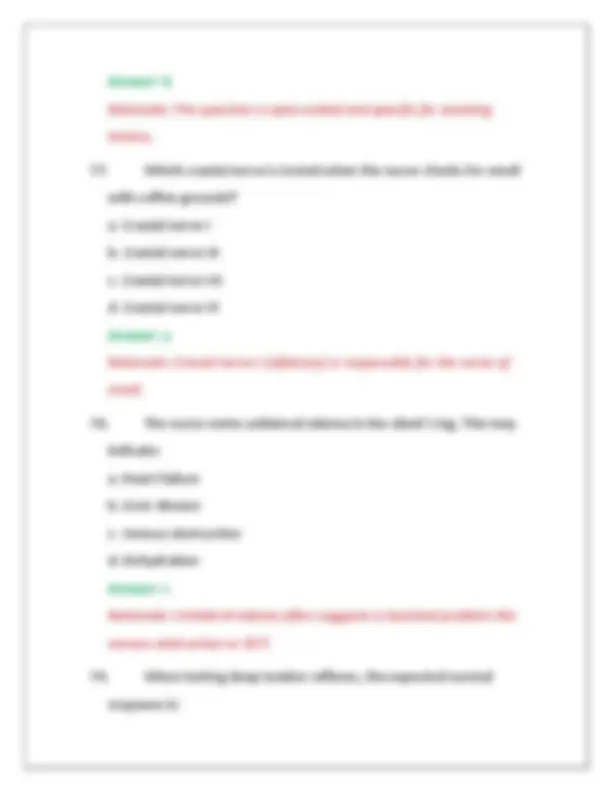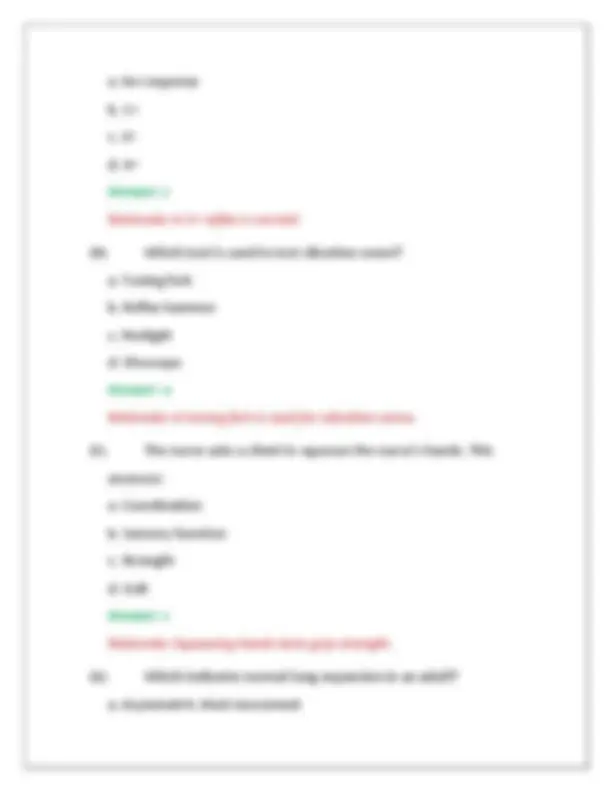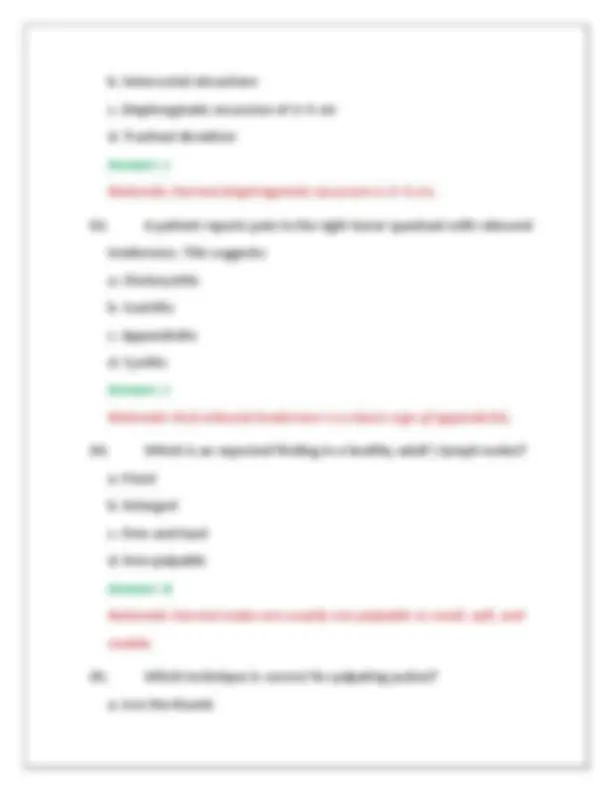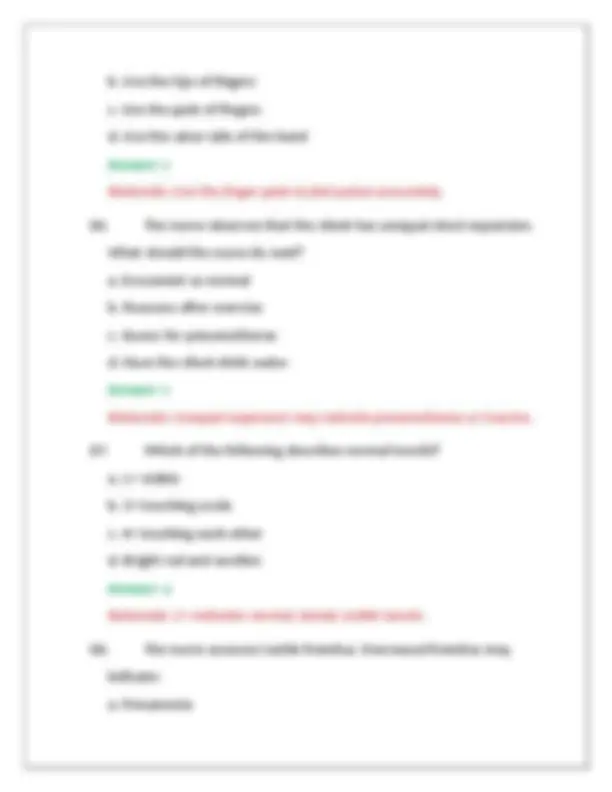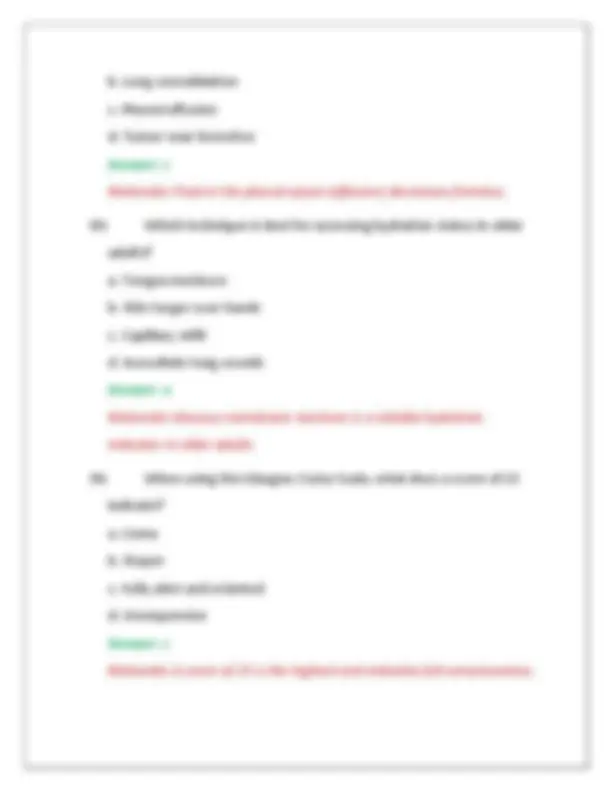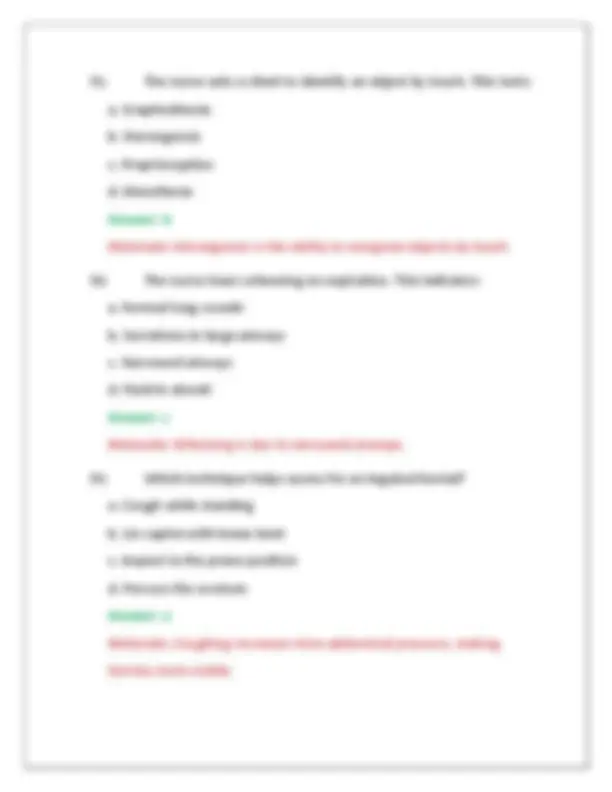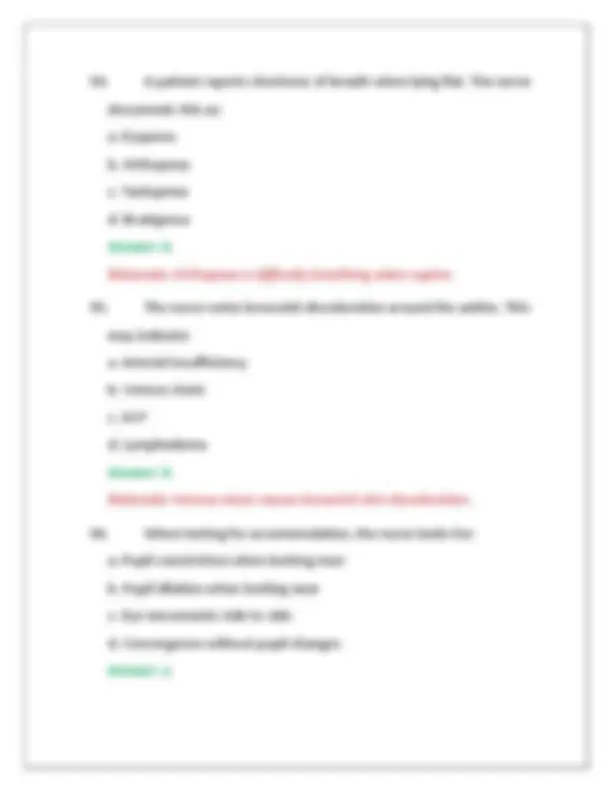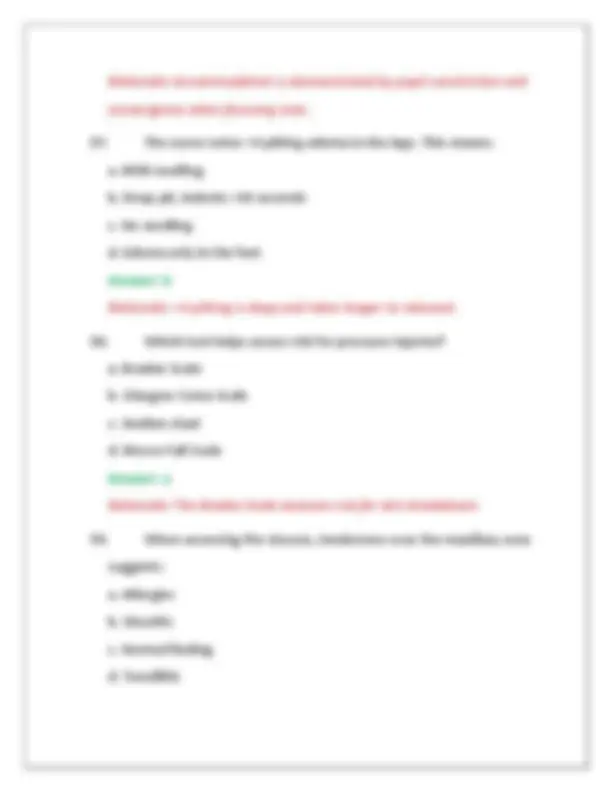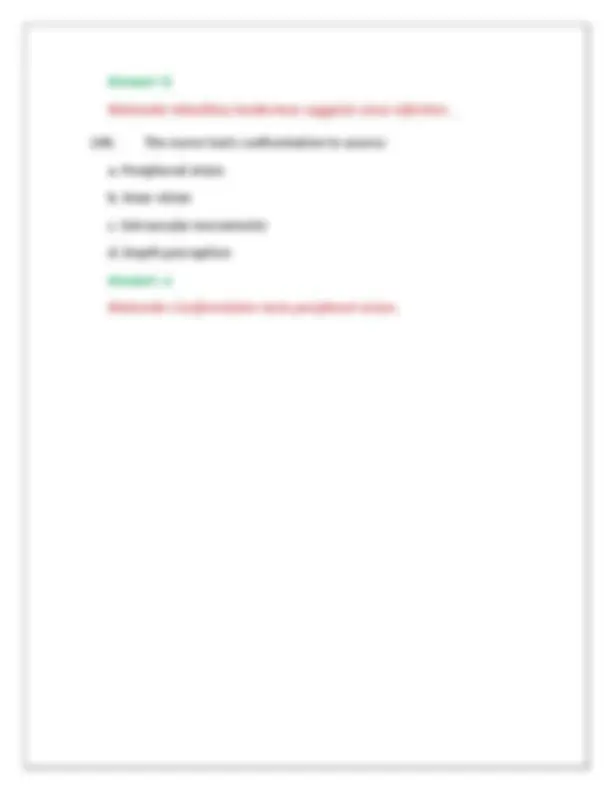Download NSG 1600 HEALTH ASSESSMENT MIDTERM EXAM 1 QUESTIONS AND CORRECT ANSWERS (VERIFIED ANSWER and more Exams Nursing in PDF only on Docsity!
NSG 1600 HEALTH ASSESSMENT MIDTERM
EXAM 1 QUESTIONS AND CORRECT
ANSWERS (VERIFIED ANSWERS) PLUS
RATIONALES 2025 GALEN COLLEGE OF
NURSING
- A nurse is performing a health history on a new client. Which question best assesses the client’s chief complaint? a. "Can you describe what brought you here today?" b. "Do you have any family history of illness?" c. "What medications do you take daily?" d. "How much exercise do you get weekly?" Answer: a Rationale: This open-ended question invites the client to describe their main concern in their own words.
- When performing an abdominal assessment, the nurse should: a. Palpate before auscultating
b. Auscultate before palpating c. Percuss before inspecting d. Perform deep palpation before inspection Answer: b Rationale: Auscultation is done before palpation to avoid altering bowel sounds.
- The nurse notes that a client’s pupils constrict when exposed to light. This is an assessment of which cranial nerve? a. Cranial nerve II b. Cranial nerve III c. Cranial nerve IV d. Cranial nerve VI Answer: b Rationale: Cranial nerve III (oculomotor) controls pupil constriction.
- Which technique is best for assessing skin turgor in an older adult? a. Pinch the skin on the back of the hand b. Pinch the skin over the clavicle c. Press on the nail beds d. Inspect the lower legs Answer: b Rationale: Skin over the clavicle is less affected by aging and provides a better indication of turgor in older adults.
Rationale: A normal tympanic membrane is pearly gray, shiny, and slightly concave.
- The nurse palpates a thrill over the precordium. What does this indicate? a. Normal finding b. Bruit c. Murmur d. Turbulent blood flow Answer: d Rationale: A thrill is a palpable vibration indicating turbulent blood flow, often from a heart murmur.
- Which of the following is true about the Weber test? a. It compares air and bone conduction b. It assesses visual acuity c. It evaluates lateralization of sound d. It measures pupil reactivity Answer: c Rationale: The Weber test assesses whether sound is heard equally in both ears (lateralization).
- When palpating the radial pulse, the nurse notes it is irregular. What is the nurse’s best action? a. Ignore it, as it is normal b. Palpate the carotid pulse instead
c. Count the apical pulse for one full minute d. Immediately notify the provider Answer: c Rationale: An irregular radial pulse should be verified by auscultating the apical pulse for a full minute.
- The nurse uses the bell of the stethoscope to assess for: a. High-pitched lung sounds b. Low-pitched heart murmurs c. Bowel sounds d. High-pitched bruits Answer: b Rationale: The bell is best for hearing low-pitched sounds like certain murmurs or bruits.
- Which assessment is appropriate when checking for jugular vein distention (JVD)? a. Position the client supine with head elevated 30–45 degrees b. Have the client sit upright at 90 degrees c. Place the client in Trendelenburg position d. Have the client stand with arms overhead Answer: a Rationale: JVD is best assessed with the client semi-Fowler’s at 30– 45 degrees.
d. "Men do not need to perform this exam." Answer: c Rationale: Monthly exams 5–7 days after menstruation are recommended for best accuracy.
- Which position is appropriate for the nurse to assess heart sounds? a. Standing and leaning backward b. Supine only c. Sitting up and leaning forward d. Trendelenburg Answer: c Rationale: Sitting up and leaning forward enhances certain heart sounds, especially murmurs.
- What is the best approach for assessing pain in a nonverbal client? a. Use a numeric scale b. Observe facial expressions and body movements c. Ask family for a report d. Avoid assessing pain Answer: b Rationale: Nonverbal cues like grimacing, restlessness, or guarding help assess pain in nonverbal clients.
- The nurse is percussing the lungs and hears hyperresonance. This may indicate: a. Pneumonia b. Pleural effusion c. Normal finding d. Emphysema Answer: d Rationale: Hyperresonance suggests air trapping, as seen in emphysema.
- Which lymph nodes are palpated just in front of the ear? a. Submandibular b. Preauricular c. Occipital d. Supraclavicular Answer: b Rationale: Preauricular nodes are located in front of the ear.
- Which tool is used to assess distant visual acuity? a. Penlight b. Otoscope c. Snellen chart d. Reflex hammer Answer: c Rationale: The Snellen chart measures distant visual acuity.
Answer: c Rationale: Tactile fremitus is assessed by palpation.
- The nurse notices clubbing of the client’s fingers. What is the most likely cause? a. Dehydration b. Chronic hypoxia c. Liver disease d. Malnutrition Answer: b Rationale: Clubbing is associated with long-term hypoxia, as in COPD.
- When assessing a client’s mental status, the nurse should first determine: a. Orientation b. Abstract thinking c. Judgment d. Memory Answer: a Rationale: Orientation to person, place, and time is the primary mental status check.
- Which finding is an expected change in the older adult’s chest shape? a. Barrel chest b. Pectus excavatum
c. Funnel chest d. Pigeon chest Answer: a Rationale: A slight barrel chest may be a normal age-related finding.
- The nurse palpates a mass in the left lower quadrant (LLQ). Which organ is likely involved? a. Liver b. Gallbladder c. Spleen d. Sigmoid colon Answer: d Rationale: The sigmoid colon is located in the LLQ.
- Which sign indicates dehydration in a client? a. Moist mucous membranes b. Strong skin turgor c. Dry tongue and cracked lips d. Bounding pulse Answer: c Rationale: Dry mucous membranes and cracked lips are signs of dehydration.
- To assess for the presence of edema, the nurse should: a. Auscultate the heart b. Inspect pupils
c. Fixed and hard nodes d. Nodes that disappear when supine Answer: c Rationale: Fixed, hard nodes may indicate malignancy.
- The nurse hears a bruit over the carotid artery. What does this suggest? a. Normal blood flow b. Turbulent blood flow due to narrowing c. Heart murmur d. Pulmonary edema Answer: b Rationale: A bruit indicates turbulent blood flow, often from arterial narrowing.
- Which is an example of subjective data? a. BP 120/80 mmHg b. Patient reports nausea c. Lungs clear on auscultation d. Redness around the incision Answer: b Rationale: Subjective data is what the client reports or feels.
- The nurse is assessing cranial nerve VII. Which action is appropriate? a. Ask the client to shrug shoulders
b. Test tongue movement c. Test facial symmetry by asking client to smile d. Check pupillary response Answer: c Rationale: Cranial nerve VII (facial) controls facial movements.
- Which assessment finding is most concerning in an elderly client? a. Slight kyphosis b. Unequal pupils c. Thin, dry skin d. Decreased lung elasticity Answer: b Rationale: Unequal pupils can indicate increased intracranial pressure or nerve damage and is always concerning.
- When assessing a client’s gait, the nurse notes shuffling steps and stooped posture. This finding is common with: a. Parkinson’s disease b. Stroke recovery c. Normal aging d. Osteoarthritis Answer: a
b. III, IV, VI c. I, II, III d. III, VII, IX Answer: b Rationale: EOMs involve cranial nerves III (oculomotor), IV (trochlear), and VI (abducens).
- Which position is best for auscultating heart murmurs? a. Right lateral b. Prone c. Sitting, leaning forward d. Supine with knees flexed Answer: c Rationale: Sitting up and leaning forward can enhance murmur sounds, especially aortic murmurs.
- What is the normal expected percussion note over most of the lung fields? a. Flatness b. Dullness c. Resonance d. Tympany Answer: c Rationale: Resonance is the normal sound over healthy lung tissue.
- The nurse detects a palpable, movable, small node in the axilla. What is the best action? a. Document as normal b. Notify the provider immediately c. Perform a biopsy d. Ignore the finding Answer: a Rationale: Small, soft, movable nodes are common and usually normal.
- Which finding would indicate a positive Romberg test? a. Swaying with eyes open b. Swaying with eyes closed c. Equal arm strength d. No movement when standing Answer: b Rationale: Swaying with eyes closed indicates loss of position sense and is a positive Romberg.
- The nurse asks a client to say “ahh” and observes the uvula rising midline. Which cranial nerve is intact? a. Cranial nerve IX b. Cranial nerve VII c. Cranial nerve VIII d. Cranial nerve X
Answer: c Rationale: Hairless, shiny skin indicates arterial insufficiency.
- When performing percussion over the liver, the expected sound is: a. Resonance b. Hyperresonance c. Tympany d. Dullness Answer: d Rationale: The liver is a solid organ and should sound dull on percussion.
- Which statement shows a client understands testicular self- exam teaching? a. "I should do this every week." b. "I don’t need to do this if I have no pain." c. "I should perform this monthly in a warm shower." d. "It should be done only by my doctor." Answer: c Rationale: Warmth relaxes the scrotum, making lumps easier to detect.
- The nurse palpates the PMI (point of maximal impulse). Where should it be located? a. Second intercostal space, right sternal border
b. Third intercostal space, left sternal border c. Fourth intercostal space, midclavicular line d. Fifth intercostal space, midclavicular line Answer: d Rationale: The PMI is normally at the fifth ICS, MCL.
- Which finding should the nurse report immediately? a. Tactile fremitus over upper lung fields b. Absent bowel sounds for 5 minutes c. Jugular vein distention at 30 degrees d. Regular S1 and S2 sounds Answer: c Rationale: JVD may indicate right-sided heart failure or fluid overload.
- Which question is appropriate when assessing a client’s nutritional status? a. "How much water do you drink daily?" b. "Do you have any moles?" c. "How often do you exercise?" d. "Are you allergic to latex?" Answer: a Rationale: Fluid intake is part of nutritional assessment.
- Which of the following is an example of inspection? a. Using a stethoscope for lung sounds b. Palpating pulses

